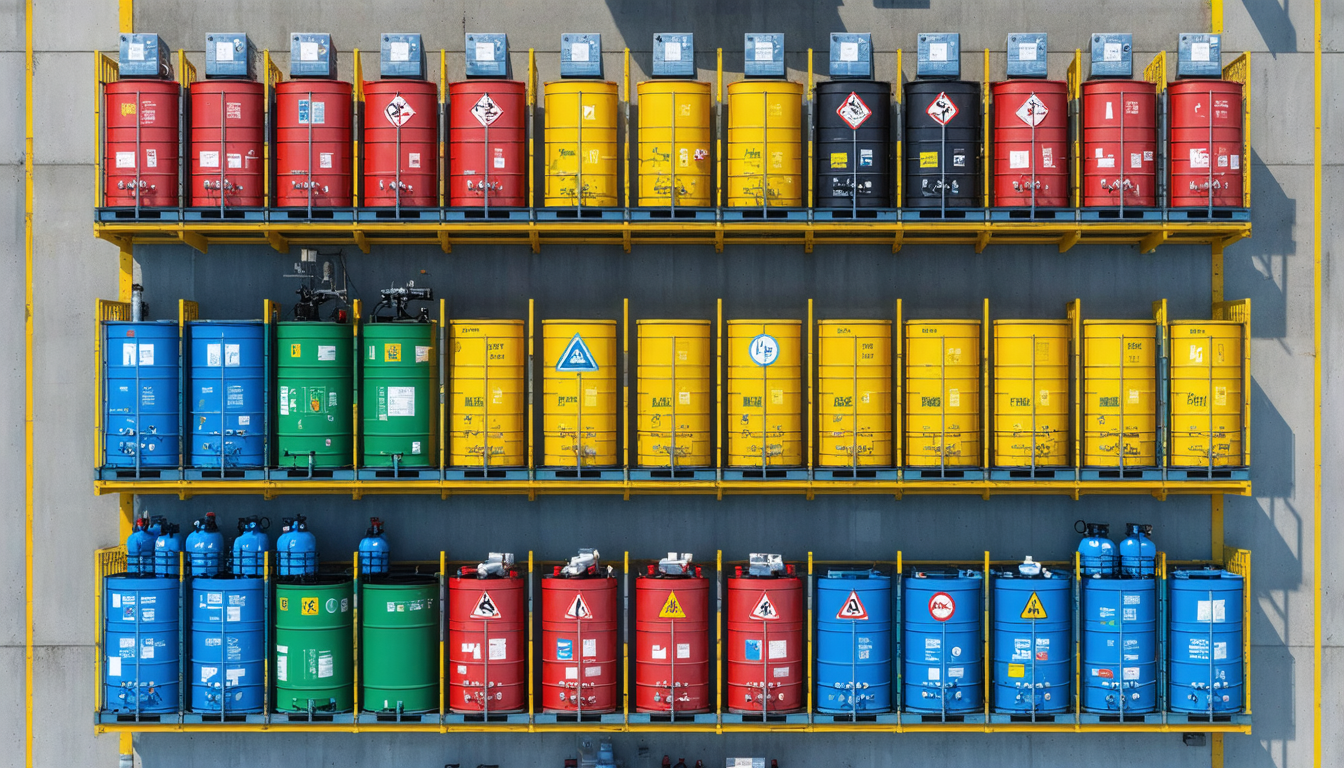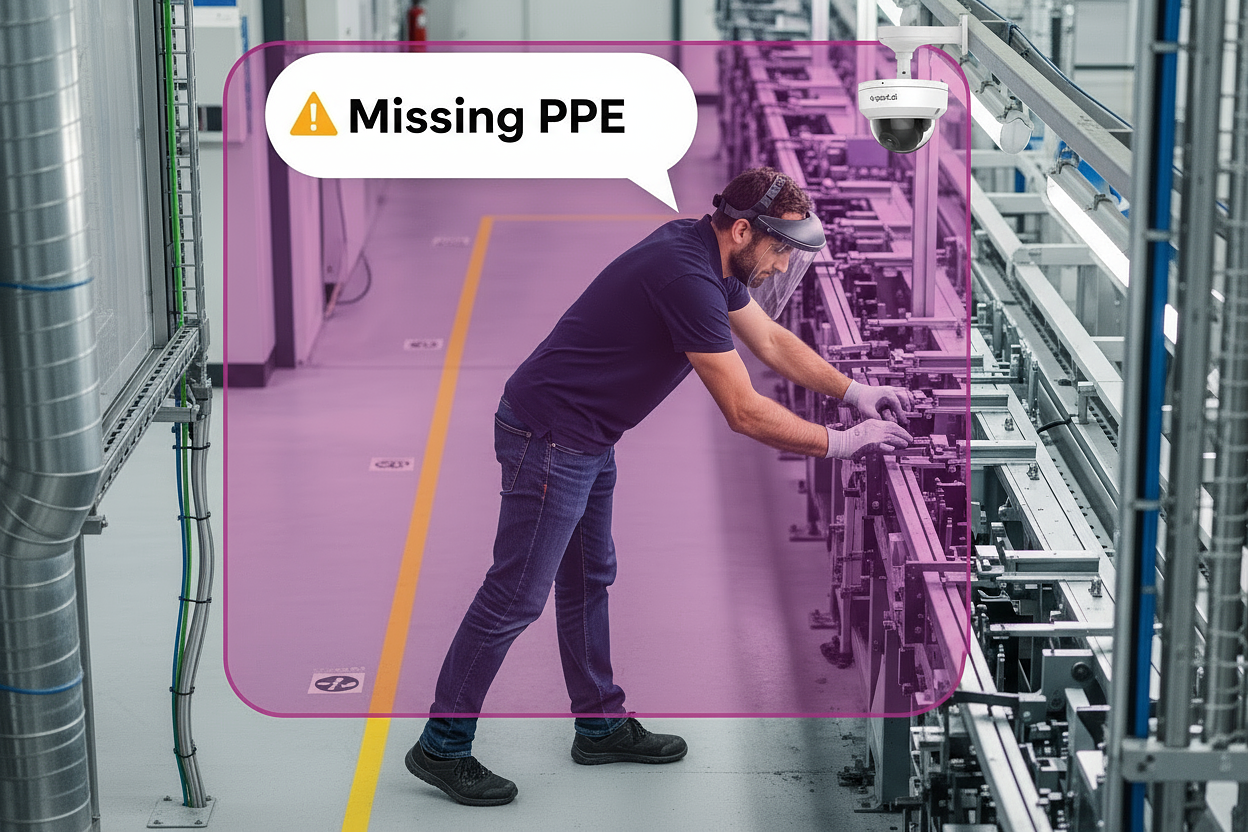Each year, hazardous substance exposure remains one of the most complex safety issues facing the manufacturing sector. In 2023, chemical burns accounted for nearly 60% of all workplace injuries from harmful substances in manufacturing.
The likelihood of nearly all hazardous substance exposures can be reduced with a reliable mix of safety protocols, training, and technology. By layering new tools like AI-powered video analytics onto proven safety practices, manufacturing leaders can shift from responding to events to addressing them before they escalate. This guide breaks down the costs, root causes, and offers a clear framework for moving from a reactive to a forward-thinking safety model using current technology.
Why hazardous substance exposure is a major risk for manufacturing
Hazardous substance exposure is one of the most costly and disruptive types of workplace occurrences in manufacturing.
Chemical burns are a substantial and frequent type of injury resulting from hazardous substance exposure.
Direct costs from a single severe event—including medical expenses, workers’ compensation, and legal fees—can be substantial.
Indirect costs, such as lost productivity, overtime, and hiring replacement workers, can often exceed the direct costs of an occurrence.
The U.S. manufacturing sector saw 2.7 injury and illness cases per 100 full-time workers in 2022, with 1.7 of those involving days away from work, job transfer, or restriction (Source: U.S. Bureau of Labor Statistics, 2023).
OSHA penalties for these violations average $12,482, with some cases topping $100,000 (Source: OSHA).
Beyond the numbers, every event causes disruptions: production lines pause, teams are pulled away to respond, and investigations divert valuable resources. Repeat violations can also draw unwanted attention from regulators and drive up insurance costs for years.
The top 5 reasons for hazardous substance exposure in manufacturing—and forward-looking safety measures
Understanding why these events happen—and how to reduce their likelihood—is the foundation of any effective safety program. Here are the five leading causes of hazardous substance exposure in manufacturing, along with practical mitigation strategies and how current technology can assist.
1. Inadequate Use of Personal Protective Equipment (PPE)
The Hazard: A maintenance technician is called to clear a jam on a paint line. In a rush to get production moving, he skips his gloves and face shield “just this once.” A splash of solvent lands on his skin, causing chemical burns. OSHA data show that PPE non-compliance remains a common factor in exposure cases, even when equipment is available.
Traditional Mitigation:
PPE policies and mandatory signage in hazardous areas.
Regular toolbox talks and safety briefings.
Supervisory checks and peer reminders.
How AI Amplifies Mitigation: Video analytics detect when workers enter hazardous zones without the required PPE. Automated alerts let supervisors step in promptly, rather than discovering a lapse after a mishap. Over time, data points reveal patterns and hotspots, empowering teams to fine-tune training and accountability.
2. Unsafe Chemical Handling and Mixing Procedures

The Hazard: In one recent case, two workers at an electroplating facility used the wrong hose to drain a tank, accidentally mixing hydrochloric acid with residual chlorine. The resulting reaction released toxic gas, leading to respiratory distress.
Traditional Mitigation:
Standard operating procedures (SOPs) for handling and mixing chemicals.
Clear labeling and color-coding of containers and hoses.
Routine audits and event reviews.
How AI Amplifies Mitigation: AI-powered video can spot when workers deviate from SOPs—such as using the wrong equipment or entering chemical storage rooms unauthorized. Swift notifications allow teams to intervene before a mix-up escalates. Reviewable video evidence also streamlines root cause analysis, so mistakes become learning opportunities.
3. Poor Ventilation and Engineering Controls
The Hazard: A plating line supervisor notices a haze in the air as the exhaust fans go offline for maintenance. Minutes later, workers in the adjacent bay start coughing and report eye irritation. Without reliable ventilation, airborne exposures spike quickly—sometimes before anyone realizes there’s an issue.
Traditional Mitigation:
Scheduled maintenance of ventilation and exhaust systems.
Air quality testing and monitoring.
Emergency drills and evacuation plans.
How AI Amplifies Mitigation: Video AI monitors occupancy and workflow, flagging crowding or unauthorized presence in high-risk areas when ventilation is offline. The system supports rapid evacuation and event response, reducing exposure windows.
4. Complacency and Behavioral Shortcuts
The Hazard: A veteran worker feels confident enough to bypass a lockout/tagout procedure for a quick repair inside a chemical tank. Complacency—often built up over years without a mishap—leads to skipped safety checks and unnecessary risk.
Traditional Mitigation:
Behavioral safety observations and peer-to-peer coaching.
Regular retraining and scenario-based drills.
Anonymous reporting systems for at-risk behaviors.
How AI Amplifies Mitigation: Video analytics can detect running, loitering, or other unsafe behaviors that signal a shortcut is being taken. Patterns of repeated risky actions are surfaced for preemptive coaching, while automated alerts prompt a swift intervention to reduce the risk of a close call or exposure.
5. Inadequate Emergency Response and Access to Decontamination

The Hazard: A spill occurs, but the nearest safety shower is blocked by stored materials. Delays in decontamination can turn a minor splash into a severe injury.
Traditional Mitigation:
Regular inspection and testing of safety showers and eyewash stations.
Clear access routes and routine housekeeping.
Emergency response training and drills.
How AI Amplifies Mitigation: AI-driven video monitoring helps verify that emergency equipment remains accessible and that pathways are clear. If an area becomes blocked, automated alerts prompt a rapid response—minimizing response times when delays can worsen outcomes.
Integrating a video AI camera system: From NVR to AI insights in manufacturing
Upgrading your safety tech doesn’t mean tearing out everything you have. Today’s AI camera platforms are built to work with your existing infrastructure—including standard POE and legacy cameras. No need for a costly “rip-and-replace.” Instead, you add a plug-and-play hardware bridge that connects on-prem cameras to a secure, cloud-native dashboard.
Why a Cloud NVR with AI Is a Major Upgrade
Feature |
Traditional NVR System |
Video AI Platform |
|---|---|---|
Camera Compatibility |
Requires new/specific models |
Works with existing POE/legacy |
Storage |
On-premise hardware |
Secure, cloud-native, scalable |
Maintenance |
Frequent, on-site |
Minimal, remote updates |
User Access |
Limited seats |
Unlimited users, unified dashboard |
Incident Review |
Manual, slow |
AI-powered search & detection |
Anticipatory Alerts & Reports |
Passive footage |
Real-time alerts for safety risks |
With the AI analysis layer, every camera becomes an anticipatory safety tool. The platform automatically surfaces critical events—like missing PPE, unsafe behavior, or no-go zone violations—so your team can act to mitigate risks before they escalate. Unlimited user seats allow safety, operations, and IT teams to access key data from a single dashboard.
Practical Tips for Manufacturing Teams
Start with a risk assessment: Identify your highest-risk areas and current camera coverage.
Prioritize solutions that support your existing policies: Verify that the technology aligns with OSHA standards and your safety management system.
Choose platforms that offer live alerts and easy integration: Look for options that work with your current cameras and require little additional training.
Involve your IT and EHS teams early: Collaboration ensures smooth rollout and long-term adoption.
Use data to drive ongoing improvement: Historic footage and analytics enable you to spot trends and refine your safety protocols over time.
Strengthen your safety program with video AI
Every hazardous substance exposure is a chance to get better—not just to respond. By combining proven safety protocols with AI-driven video analytics, manufacturing leaders can lower event rates, speed up investigations, and foster a safer work culture.
Want to see how video AI can assist your team reduce hazardous substance events? Request a demo to experience Spot AI in action for manufacturing safety.
Frequently asked questions
What are the most common causes of hazardous substance exposure in manufacturing?
The leading causes include inadequate PPE use, unsafe chemical handling, poor ventilation, complacency, and lack of access to emergency decontamination equipment. These factors are common contributors to workplace occurrences across the manufacturing sector.
How can manufacturing organizations implement safety technology without disrupting production?
Video AI platforms are designed to overlay analytics on your existing camera feeds, with plug-and-play hardware that requires minimal downtime. They automate hazard detection, supporting your safety teams without interfering with daily operations.
What compliance standards apply to hazardous substance safety in manufacturing?
Key requirements include OSHA’s Hazard Communication Standard (29 CFR 1910.1200), which mandates safety data sheets (SDS), employee training, and chemical labeling. OSHA also sets permissible exposure limits (PELs) for specific substances, while regular audits and scenario-based training are considered industry best practices (Source: Occupational Safety and Health Administration)..
What practical steps should manufacturers take before adopting AI camera technology?
Begin with a thorough safety risk assessment, review current camera infrastructure, and involve both IT and EHS teams from the start. Pilot the system in high-risk areas, analyze the results, and expand based on data-driven improvements.
How does AI-powered video analytics support incident investigations?
The platform automatically flags events—such as missing PPE, unsafe entry into hazardous zones, or crowding—making it easy to review relevant footage, understand root causes, and support faster, more accurate investigations for compliance and insurance.
How can safety technology reduce stress for safety professionals?
AI-driven analytics automate the detection of hazards and compliance gaps, freeing safety professionals from time-consuming manual monitoring and paperwork. This allows them to focus on coaching, training, and process refinement rather than chasing down every occurrence.
What is the best camera analytics software for workplace safety?
The best software shifts your team from reactive monitoring to anticipatory safety. It should work with your existing cameras, deliver real-time alerts for hazards like missing PPE or no-go zone entry, and provide a unified cloud dashboard for easy collaboration and fast, AI-powered event review.
About the author
Joshua Foster is an IT Systems Engineer at Spot AI, where he helps ensure the Spot AI platform is secure, scalable, and easy for customers to integrate into their existing operations. He focuses on managing cloud infrastructure and automating system workflows to deliver a reliable, enterprise-ready solution that turns any camera into an intelligent teammate.

























.png)
.png)
.png)